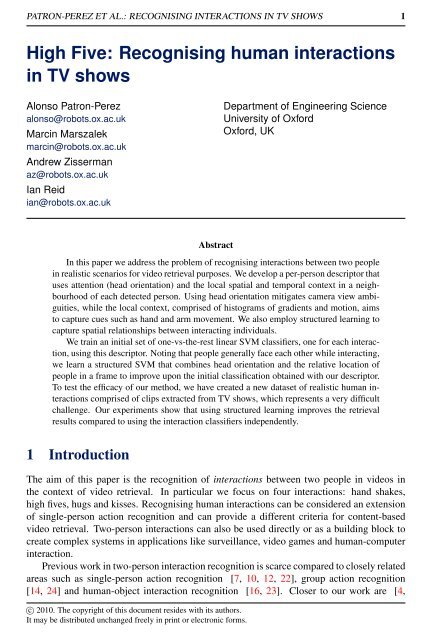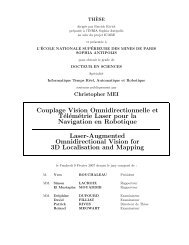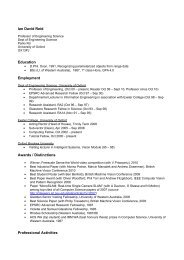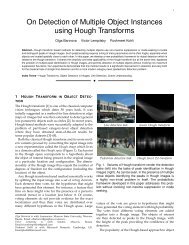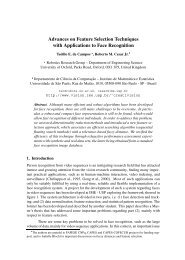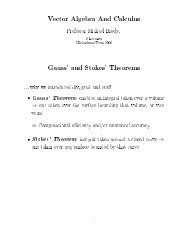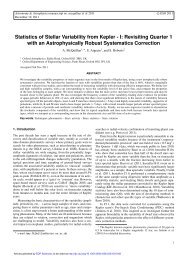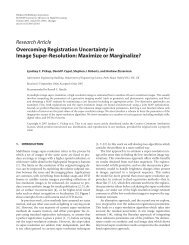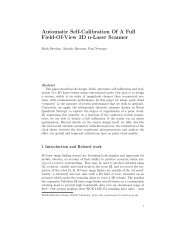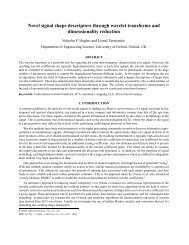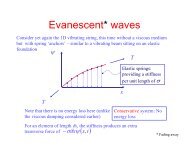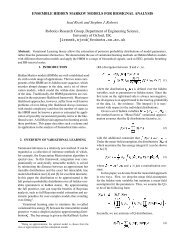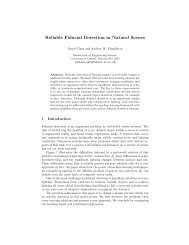High Five: Recognising human interactions in TV shows - Robotics ...
High Five: Recognising human interactions in TV shows - Robotics ...
High Five: Recognising human interactions in TV shows - Robotics ...
Create successful ePaper yourself
Turn your PDF publications into a flip-book with our unique Google optimized e-Paper software.
PATRON-PEREZ ET AL.: RECOGNISING INTERACTIONS IN <strong>TV</strong> SHOWS 1<br />
<strong>High</strong> <strong>Five</strong>: <strong>Recognis<strong>in</strong>g</strong> <strong>human</strong> <strong><strong>in</strong>teractions</strong><br />
<strong>in</strong> <strong>TV</strong> <strong>shows</strong><br />
Alonso Patron-Perez<br />
alonso@robots.ox.ac.uk<br />
Marc<strong>in</strong> Marszalek<br />
marc<strong>in</strong>@robots.ox.ac.uk<br />
Andrew Zisserman<br />
az@robots.ox.ac.uk<br />
Ian Reid<br />
ian@robots.ox.ac.uk<br />
Abstract<br />
Department of Eng<strong>in</strong>eer<strong>in</strong>g Science<br />
University of Oxford<br />
Oxford, UK<br />
In this paper we address the problem of recognis<strong>in</strong>g <strong><strong>in</strong>teractions</strong> between two people<br />
<strong>in</strong> realistic scenarios for video retrieval purposes. We develop a per-person descriptor that<br />
uses attention (head orientation) and the local spatial and temporal context <strong>in</strong> a neighbourhood<br />
of each detected person. Us<strong>in</strong>g head orientation mitigates camera view ambiguities,<br />
while the local context, comprised of histograms of gradients and motion, aims<br />
to capture cues such as hand and arm movement. We also employ structured learn<strong>in</strong>g to<br />
capture spatial relationships between <strong>in</strong>teract<strong>in</strong>g <strong>in</strong>dividuals.<br />
We tra<strong>in</strong> an <strong>in</strong>itial set of one-vs-the-rest l<strong>in</strong>ear SVM classifiers, one for each <strong>in</strong>teraction,<br />
us<strong>in</strong>g this descriptor. Not<strong>in</strong>g that people generally face each other while <strong>in</strong>teract<strong>in</strong>g,<br />
we learn a structured SVM that comb<strong>in</strong>es head orientation and the relative location of<br />
people <strong>in</strong> a frame to improve upon the <strong>in</strong>itial classification obta<strong>in</strong>ed with our descriptor.<br />
To test the efficacy of our method, we have created a new dataset of realistic <strong>human</strong> <strong><strong>in</strong>teractions</strong><br />
comprised of clips extracted from <strong>TV</strong> <strong>shows</strong>, which represents a very difficult<br />
challenge. Our experiments show that us<strong>in</strong>g structured learn<strong>in</strong>g improves the retrieval<br />
results compared to us<strong>in</strong>g the <strong>in</strong>teraction classifiers <strong>in</strong>dependently.<br />
1 Introduction<br />
The aim of this paper is the recognition of <strong><strong>in</strong>teractions</strong> between two people <strong>in</strong> videos <strong>in</strong><br />
the context of video retrieval. In particular we focus on four <strong><strong>in</strong>teractions</strong>: hand shakes,<br />
high fives, hugs and kisses. <strong>Recognis<strong>in</strong>g</strong> <strong>human</strong> <strong><strong>in</strong>teractions</strong> can be considered an extension<br />
of s<strong>in</strong>gle-person action recognition and can provide a different criteria for content-based<br />
video retrieval. Two-person <strong><strong>in</strong>teractions</strong> can also be used directly or as a build<strong>in</strong>g block to<br />
create complex systems <strong>in</strong> applications like surveillance, video games and <strong>human</strong>-computer<br />
<strong>in</strong>teraction.<br />
Previous work <strong>in</strong> two-person <strong>in</strong>teraction recognition is scarce compared to closely related<br />
areas such as s<strong>in</strong>gle-person action recognition [7, 10, 12, 22], group action recognition<br />
[14, 24] and <strong>human</strong>-object <strong>in</strong>teraction recognition [16, 23]. Closer to our work are [4,<br />
c○ 2010. The copyright of this document resides with its authors.<br />
It may be distributed unchanged freely <strong>in</strong> pr<strong>in</strong>t or electronic forms.
2 PATRON-PEREZ ET AL.: RECOGNISING INTERACTIONS IN <strong>TV</strong> SHOWS<br />
Figure 1: Dataset snapshots. Note the variation <strong>in</strong> the actors, scale and camera views.<br />
17, 19], where <strong><strong>in</strong>teractions</strong> are generally recognised <strong>in</strong> a hierarchical manner putt<strong>in</strong>g special<br />
attention on higher level descriptions and us<strong>in</strong>g very constra<strong>in</strong>ed data. These approaches<br />
rely heavily upon many low level image pre-process<strong>in</strong>g steps like background subtraction<br />
and segmentation of body parts which are, by themselves, very difficult problems to solve<br />
when work<strong>in</strong>g with more complex scenarios. In contrast, recent publications on s<strong>in</strong>gle-action<br />
recognition have shown a natural move from simplified and constra<strong>in</strong>ed datasets to more<br />
realistic ones [11, 12, 13, 21, 22]. One of the contributions of this paper is the compilation<br />
of a realistic <strong>human</strong> <strong>in</strong>teraction dataset extracted from a collection of <strong>TV</strong> <strong>shows</strong> (Section 2).<br />
Work<strong>in</strong>g with realistic datasets <strong>in</strong>troduces a new set of challenges that have to be addressed<br />
<strong>in</strong> order to achieve successful recognition: background clutter, a vary<strong>in</strong>g number of people<br />
<strong>in</strong> the scene, camera motion and changes of camera viewpo<strong>in</strong>ts, to name a few.<br />
Our approach is to <strong>in</strong>troduce a person-centred descriptor that uses a comb<strong>in</strong>ation of simple<br />
features to deal <strong>in</strong> a systematic way with these challenges. An upper body detector [6]<br />
is first used to f<strong>in</strong>d people <strong>in</strong> every frame of the video (Section 3). The detections are then<br />
clustered to form tracks. A track is def<strong>in</strong>ed as a set of upper body bound<strong>in</strong>g boxes, <strong>in</strong> consecutive<br />
frames, correspond<strong>in</strong>g to the same person. The aim of this first step is to reduce the<br />
search space for <strong><strong>in</strong>teractions</strong> to a l<strong>in</strong>ear search along each track <strong>in</strong> an analogous way as [9].<br />
We then calculate descriptors along these tracks and use them to learn a Support Vector Mach<strong>in</strong>e<br />
(SVM) classifier for each <strong>in</strong>teraction. Then <strong>in</strong>teraction scores are computed for each<br />
bound<strong>in</strong>g box of each track. We also use the head orientation of people detected <strong>in</strong> two novel<br />
ways: first to achieve a weak view <strong>in</strong>variance <strong>in</strong> the descriptor (see Section 3), and second<br />
to learn <strong>in</strong>teraction-based spatial relations between people (Section 4). The latter is based<br />
on our assumption that people generally face each other while <strong>in</strong>teract<strong>in</strong>g. This assumption<br />
is used to learn a structured SVM [20] that is tra<strong>in</strong>ed to obta<strong>in</strong> the best jo<strong>in</strong>t classification<br />
of a group of people <strong>in</strong> a frame. We show that us<strong>in</strong>g structured learn<strong>in</strong>g (SL) can improve<br />
the retrieval results obta<strong>in</strong>ed by <strong>in</strong>dependently classify<strong>in</strong>g each track. An additional characteristic<br />
of our structured formulation is that it provides <strong>in</strong>formation about which people<br />
are <strong>in</strong>teract<strong>in</strong>g. In Section 4.2 we show the retrieval results obta<strong>in</strong>ed by the <strong>in</strong>dividual and<br />
structured track classification. Section 5 presents our conclusions and future work.<br />
2 Dataset<br />
We have compiled a dataset of 300 video clips extracted from 23 different <strong>TV</strong> <strong>shows</strong> 1 . Each<br />
of the clips conta<strong>in</strong>s one of four <strong><strong>in</strong>teractions</strong>: hand shake, high five, hug and kiss (each<br />
1 http://www.robots.ox.ac.uk/∼vgg/data/tv_<strong>human</strong>_<strong><strong>in</strong>teractions</strong>
PATRON-PEREZ ET AL.: RECOGNISING INTERACTIONS IN <strong>TV</strong> SHOWS 3<br />
appear<strong>in</strong>g <strong>in</strong> 50 videos). Negative examples (clips that don’t conta<strong>in</strong> any of the <strong><strong>in</strong>teractions</strong>)<br />
make up the rema<strong>in</strong><strong>in</strong>g 100 videos. The length of the video clips ranges from 30 to 600<br />
frames. The <strong><strong>in</strong>teractions</strong> are not temporally aligned (i.e. a clip conta<strong>in</strong><strong>in</strong>g a hand shake<br />
might start with people walk<strong>in</strong>g towards each other or directly at the moment of the hand<br />
shake). There is a great degree of variation between different clips and also <strong>in</strong> several cases<br />
with<strong>in</strong> the same clip (Figure 1). Such variation <strong>in</strong>cludes the number of actors <strong>in</strong> each scene,<br />
their scales and the camera angle, <strong>in</strong>clud<strong>in</strong>g abrupt viewpo<strong>in</strong>t changes (shot boundaries).<br />
To have a ground truth for the evaluation of the methods developed <strong>in</strong> this paper, we<br />
have annotated every frame of each video with the follow<strong>in</strong>g: the upper body, discrete head<br />
orientation and <strong>in</strong>teraction label of all persons present whose upper body size is with<strong>in</strong> a<br />
certa<strong>in</strong> range. This range goes from far shots that show the whole body to medium shots<br />
where only the upper body is visible and is equivalent to 50-350 pixels <strong>in</strong> our videos. We<br />
have also annotated which persons are <strong>in</strong>teract<strong>in</strong>g, if any, <strong>in</strong> each frame. For the purposes<br />
of tra<strong>in</strong><strong>in</strong>g and test<strong>in</strong>g, the dataset has been split <strong>in</strong>to two groups, each conta<strong>in</strong><strong>in</strong>g videos<br />
of mutually exclusive <strong>TV</strong> <strong>shows</strong>. The experiments shown <strong>in</strong> the follow<strong>in</strong>g sections were<br />
performed us<strong>in</strong>g one set for tra<strong>in</strong><strong>in</strong>g, the other for test<strong>in</strong>g and vice versa.<br />
3 Model<strong>in</strong>g <strong>human</strong> activity<br />
Because of the complexity and variability of the videos <strong>in</strong> our dataset, f<strong>in</strong>d<strong>in</strong>g relevant and<br />
dist<strong>in</strong>ctive features becomes <strong>in</strong>creas<strong>in</strong>gly difficult. The descriptor has to be simultaneously<br />
(i) relatively coarse to deal with variation, and (ii) to some extent focused to avoid learn<strong>in</strong>g<br />
background noise when codify<strong>in</strong>g the <strong>in</strong>teraction. We address these po<strong>in</strong>ts by mak<strong>in</strong>g our<br />
descriptor person-centred, and by further organis<strong>in</strong>g the data based on head orientation.<br />
The person-centred descriptor focuses on the area around the upper body of a s<strong>in</strong>gle<br />
person, enabl<strong>in</strong>g us to localise regions of potential <strong>in</strong>terest and to learn relevant <strong>in</strong>formation<br />
<strong>in</strong>side them. Our descriptor does this by coarsely quantify<strong>in</strong>g appearance and motion <strong>in</strong>side<br />
this region. This is <strong>in</strong> contrast to other approaches <strong>in</strong> s<strong>in</strong>gle-action recognition [7, 11,<br />
12, 15, 22], where features are estimated <strong>in</strong> the whole frame or video and then clustered<br />
to localise where the action is happen<strong>in</strong>g. Another advantage for implement<strong>in</strong>g a personcentred<br />
descriptor is that, depend<strong>in</strong>g on the camera angle, both persons are not always visible<br />
<strong>in</strong> a given frame, and we would like to be able to provide a classification <strong>in</strong> these <strong>in</strong>stances.<br />
For the moment, we assume that we know the location and scale of people <strong>in</strong> each frame and<br />
leave the detection method for section 3.2.<br />
3.1 Person-centred descriptor<br />
The follow<strong>in</strong>g describes the process for obta<strong>in</strong><strong>in</strong>g a descriptor given an upper body location,<br />
which is repeated for each person detected <strong>in</strong> a frame. Our descriptor superimposes an 8 × 8<br />
grid around an upper body detection. The size of the grid, be<strong>in</strong>g dependent on the detection<br />
size, deals with changes of scale. We then calculate histograms of gradients and optical<br />
flow <strong>in</strong> each of its cells. An example of this can be seen <strong>in</strong> Figure 2b. This technique of<br />
us<strong>in</strong>g histograms of gradients and flow is a coarse analog to the descriptor used <strong>in</strong> [3, 11].<br />
Gradients are discretised <strong>in</strong>to five b<strong>in</strong>s: horizontal, vertical, two diagonal orientations and a<br />
no-gradient b<strong>in</strong>. Optical flow is also discretised <strong>in</strong>to five b<strong>in</strong>s: no-motion, left, right, up and<br />
down. The histograms are <strong>in</strong>dependently normalised and concatenated to create an <strong>in</strong>itial<br />
grid descriptor g (Note on notation: whenever a vector is used <strong>in</strong> this paper is considered<br />
to be <strong>in</strong> row format by default). We also experimented with several variants of the grid
4 PATRON-PEREZ ET AL.: RECOGNISING INTERACTIONS IN <strong>TV</strong> SHOWS<br />
(a) (b)<br />
Figure 2: (a) Upper body detections and estimated discrete head orientation. (b) Grid show<strong>in</strong>g<br />
dom<strong>in</strong>ant cell gradient and significant motion (red cells) for a hand shake.<br />
descriptor: us<strong>in</strong>g only motion, only gradients, only <strong>in</strong>formation of the cells outside the upper<br />
body detection as well as different normalisations. The experiments described <strong>in</strong> Section 3.3<br />
show the results obta<strong>in</strong>ed by select<strong>in</strong>g different parameters.<br />
To obta<strong>in</strong> the f<strong>in</strong>al descriptor d, we take <strong>in</strong>to account the head orientation, discretised<br />
<strong>in</strong>to one of five orientations: profile-left, front-left, front-right, profile-right and backwards.<br />
Perfect frontal views are very rare and they are <strong>in</strong>cluded <strong>in</strong> either of the two frontal categories.<br />
Effectively, we want to create a compact and automatic representation from which<br />
we can learn a different classifier for each discrete head orientation. To do this, the discrete<br />
head orientation, θ, is used to perform the follow<strong>in</strong>g operation:<br />
g + = g ⊗ δ θ , d = [g + g] (1)<br />
where ⊗ is the Kronecker product, δ θ is an <strong>in</strong>dicator vector with five elements (correspond<strong>in</strong>g<br />
to the discrete head orientations) hav<strong>in</strong>g a one at position θ and zero everywhere<br />
else. By us<strong>in</strong>g the head orientation, we are aim<strong>in</strong>g to capture <strong>in</strong>formation correlated with it.<br />
Assum<strong>in</strong>g that an <strong>in</strong>teraction occurs <strong>in</strong> the direction a person is fac<strong>in</strong>g (Figure2a) this can<br />
provide us with a weak k<strong>in</strong>d of view <strong>in</strong>variance. We add an extra copy of g at the end of the<br />
descriptor d to account for any <strong>in</strong>formation that is <strong>in</strong>dependent of the head orientation and<br />
to help <strong>in</strong> cases where the automatic estimation of the head orientation is wrong. We can<br />
duplicate the amount of examples used for tra<strong>in</strong><strong>in</strong>g by horizontally flipp<strong>in</strong>g the video frames<br />
result<strong>in</strong>g <strong>in</strong> oposite head orientations (i.e. profile-left becomes profile-right).<br />
The descriptor d is used as a data vector for tra<strong>in</strong><strong>in</strong>g a l<strong>in</strong>ear SVM classifier. An illustrative<br />
example of the results that we obta<strong>in</strong>, Figure 3, <strong>shows</strong> the motion regions (outside the<br />
upper body detection) learnt by a l<strong>in</strong>ear SVM classifier tra<strong>in</strong>ed to discrim<strong>in</strong>ate between hand<br />
shakes and high fives. As expected, important motion regions are correlated with the head<br />
orientation and occur <strong>in</strong> lower locations for hand shakes and higher ones for high fives.<br />
3.2 Localis<strong>in</strong>g <strong>human</strong>s and estimat<strong>in</strong>g head orientation<br />
To be able to use the descriptor proposed above, we need to pre-process our video clips. The<br />
pre-process<strong>in</strong>g follows the same steps as <strong>in</strong> [6], and we briefly expla<strong>in</strong> them here for completeness.<br />
First we run an upper body detector <strong>in</strong> each frame. This detector is tra<strong>in</strong>ed us<strong>in</strong>g<br />
a standard Histogram of Oriented Gradients (HOG) descriptor [2] and a simple l<strong>in</strong>ear SVM<br />
classifier. We tra<strong>in</strong> two such detectors at a different <strong>in</strong>itial scale (to improve the detection<br />
rate). Next, we cluster these detections us<strong>in</strong>g clique partition<strong>in</strong>g to form tracks. Very short<br />
tracks and tracks with low average SVM scores are elim<strong>in</strong>ated, and those that rema<strong>in</strong> are<br />
used <strong>in</strong> the experiments. As <strong>in</strong> [1, 18] we learn a classifier for discrete head orientations,
PATRON-PEREZ ET AL.: RECOGNISING INTERACTIONS IN <strong>TV</strong> SHOWS 5<br />
Figure 3: Motion weights outside upper body detection (blue square) learnt by a l<strong>in</strong>ear SVM<br />
classifier tra<strong>in</strong>ed to discrim<strong>in</strong>ate between hand shakes and high fives. <strong>High</strong>er weights are<br />
<strong>in</strong>dicated by lighter areas. As expected, the more important motion regions are <strong>in</strong> lower<br />
locations for hand shakes and <strong>in</strong> higher ones for high fives. These also follow the direction<br />
of the face.<br />
however we simply tra<strong>in</strong> a one-vs-the-rest l<strong>in</strong>ear SVM us<strong>in</strong>g HOG descriptors. Once the<br />
classifier is learnt, we estimate the head location <strong>in</strong> each bound<strong>in</strong>g box of each track and<br />
obta<strong>in</strong> a discrete head orientation classification.<br />
3.3 Experiments<br />
Given that people’s tracks have been calculated <strong>in</strong> every video as previously described, we<br />
want to evaluate the accuracy of our descriptor when classify<strong>in</strong>g <strong><strong>in</strong>teractions</strong>. We have designed<br />
a set of experiments to show the effect of: (i) not us<strong>in</strong>g head orientation <strong>in</strong>formation vs<br />
add<strong>in</strong>g it either by manual annotation or by automatic classification; (ii) chang<strong>in</strong>g descriptor<br />
<strong>in</strong>formation: us<strong>in</strong>g only motion, only gradients or both; (iii) add<strong>in</strong>g weak temporal <strong>in</strong>formation<br />
by concatenat<strong>in</strong>g descriptors of consecutive frames to form a s<strong>in</strong>gle descriptor. The<br />
term n-frame descriptor refers to a concatenation of n descriptors from consecutive frames.<br />
To be able to compare the results obta<strong>in</strong>ed, all of the experiments follow the next steps.<br />
We manually select from each clip five consecutive frames that are <strong>in</strong>side the temporal region<br />
where the <strong>in</strong>teraction is happen<strong>in</strong>g. From these frames we extract descriptors from a track<br />
of one of the people perform<strong>in</strong>g the <strong>in</strong>teraction (aga<strong>in</strong> we manually select the track). The<br />
same process is applied to the negative videos. As described <strong>in</strong> Section 2, the dataset is<br />
divided <strong>in</strong>to two sets for tra<strong>in</strong><strong>in</strong>g and test<strong>in</strong>g. We use <strong>in</strong> turn the descriptors of each set to<br />
tra<strong>in</strong> a one-vs-the-rest l<strong>in</strong>ear SVM classifier for each <strong>in</strong>teraction <strong>in</strong> a supervised way. The<br />
classification of a clip is done by add<strong>in</strong>g the SVM classification scores of each one of the<br />
descriptors extracted from its five selected frames.<br />
Figure 4 provides a visual representation of the results. Column-wise we observe accuracy<br />
results obta<strong>in</strong>ed us<strong>in</strong>g different n-frame descriptors. Row-wise represents the average<br />
accuracy when choos<strong>in</strong>g different <strong>in</strong>formation to <strong>in</strong>clude <strong>in</strong> the descriptor: only motion, only<br />
gradients and both. Each row is an average over tests us<strong>in</strong>g full or external cells and different<br />
normalisations (L1, L2 or no-norm). The table itself is an average of the results obta<strong>in</strong>ed<br />
when test<strong>in</strong>g on both sets.<br />
Several th<strong>in</strong>gs can be concluded from this representation. First, we can readily observe<br />
that the use of head orientation improves the classification accuracy when correctly esti-
6 PATRON-PEREZ ET AL.: RECOGNISING INTERACTIONS IN <strong>TV</strong> SHOWS<br />
Figure 4: Average classification accuracy results with different parameter comb<strong>in</strong>ations. No<br />
consistent improvement is noticed by us<strong>in</strong>g higher n-frame descriptors. Motion <strong>in</strong>formation<br />
is a more discrim<strong>in</strong>ative feature than gradients <strong>in</strong> three of the four <strong><strong>in</strong>teractions</strong>. On average<br />
us<strong>in</strong>g head <strong>in</strong>formation improves the accuracy. (Best viewed <strong>in</strong> color).<br />
mated, but errors when automatically classify<strong>in</strong>g the head orientation reduce it. Tak<strong>in</strong>g the<br />
best comb<strong>in</strong>ation of parameters for each <strong>in</strong>teraction (us<strong>in</strong>g 1-frame descriptors), the average<br />
accuracy when us<strong>in</strong>g manually annotated head orientation is 59.4%, for automatic head<br />
orientation 52.2% and for no head orientation 48.8%. We noted that the concatenation of<br />
descriptors did not consistently improve the classification results.<br />
Another easily dist<strong>in</strong>guishable characteristic is that the use of motion features alone has<br />
better performance when classify<strong>in</strong>g high fives and kisses, while a comb<strong>in</strong>ation of both works<br />
better for hugs. This is very <strong>in</strong>tuitive because hugs conta<strong>in</strong> m<strong>in</strong>imal motion <strong>in</strong> contrast to<br />
the other actions. The bad performance of us<strong>in</strong>g only gradients could be expla<strong>in</strong>ed by the<br />
coarseness of our descriptor, which results <strong>in</strong> learn<strong>in</strong>g gradients that are too general to be<br />
dist<strong>in</strong>ctive. We tried to improve these results by <strong>in</strong>creas<strong>in</strong>g the number of cells. The result<strong>in</strong>g<br />
<strong>in</strong>creased size of the descriptor comb<strong>in</strong>ed with a reduced number of tra<strong>in</strong><strong>in</strong>g examples led to<br />
worse classification results.<br />
4 Learn<strong>in</strong>g <strong>human</strong> <strong><strong>in</strong>teractions</strong><br />
As mentioned before, sometimes only one of the two people perform<strong>in</strong>g an <strong>in</strong>teraction appears<br />
<strong>in</strong> the video clip. However, when the location of two or more people is available <strong>in</strong> a<br />
specific frame, we should use this to improve our classification. The assumption we make<br />
is that people face each other while <strong>in</strong>teract<strong>in</strong>g. Thus we want to learn relative locations of<br />
people given both their head orientation and an <strong>in</strong>teraction label. We propose to do this by<br />
us<strong>in</strong>g a structured learn<strong>in</strong>g (SL) framework similar to the one described <strong>in</strong> [5]. The goal is to<br />
simultaneously estimate the best jo<strong>in</strong>t classification for a set of detections <strong>in</strong> a video frame<br />
rather than classify<strong>in</strong>g each detection <strong>in</strong>dependently. In contrast to [5], where SL is used<br />
to learn spatial relations between object classes, we want to learn spatial relations between<br />
people given their <strong>in</strong>teraction class and head orientation.<br />
4.1 Structured learn<strong>in</strong>g<br />
We pose the SL problem <strong>in</strong> the follow<strong>in</strong>g terms: <strong>in</strong> each frame we have a set of upper body<br />
detections X = [x1 ...xM]. Each detection xi = [lx ly s θ v], has <strong>in</strong>formation about its upper<br />
left corner location (lx,ly), scale (s), discrete head orientation (θ), and SVM classification
PATRON-PEREZ ET AL.: RECOGNISING INTERACTIONS IN <strong>TV</strong> SHOWS 7<br />
Figure 5: (a) Spatial relations (δi j) used <strong>in</strong> our structured learn<strong>in</strong>g method. The black square<br />
at the centre represents the head location <strong>in</strong>side an upper body detection. (b) Weights (β)<br />
learnt for each <strong>in</strong>teraction class and head orientation comb<strong>in</strong>ation. Lighter <strong>in</strong>tensity <strong>in</strong>dicates<br />
a higher weight.<br />
scores (v) obta<strong>in</strong>ed by classify<strong>in</strong>g the descriptor associated with this detection us<strong>in</strong>g the <strong>in</strong>teraction<br />
classifiers previously learnt. Associated with each frame is a label Y = [y1 ...yM yc].<br />
This label is formed by a class label yi ∈ {0,..,K} for each detection (where K is the number<br />
of <strong>in</strong>teraction classes, with 0 represent<strong>in</strong>g the no-<strong>in</strong>teraction class) and a configuration label<br />
yc that serves as an <strong>in</strong>dex for one of the valid pair<strong>in</strong>gs of detections. For example, for three<br />
detections there are four valid configurations: {(1,0) , (2,0), (3,0)}, {(1,0) , (2,3)} , {(1,3) ,<br />
(2,0)} and {(1,2) (3,0)}, where (i, j) <strong>in</strong>dicates that detection i is <strong>in</strong>teract<strong>in</strong>g with detection<br />
j and the 0 <strong>in</strong>dex means there is no <strong>in</strong>teraction. We measure the match between an <strong>in</strong>put X<br />
and a label<strong>in</strong>g Y by the follow<strong>in</strong>g cost function:<br />
S(X,Y) =<br />
M<br />
∑α i<br />
0 M<br />
yiθi<br />
vyi + ∑<br />
i<br />
α 1 yiθi + ∑ (δ i jβ<br />
(i, j)∈Pyc<br />
T<br />
yiθi + δ jiβ T<br />
y ) (2)<br />
jθ j<br />
where vyi is the SVM classification score for class yi of detection i, Pyc is the set of<br />
valid pairs def<strong>in</strong>ed by configuration <strong>in</strong>dex yc , δ i j and δ ji are <strong>in</strong>dicator vectors codify<strong>in</strong>g the<br />
relative location of detection j with respect to detection i (and vice versa) <strong>in</strong>to one of R = 6<br />
spatial relations shown <strong>in</strong> Figure 5a. α0 yiθi and α1 are scalar weight<strong>in</strong>g and bias parameters<br />
yiθi<br />
that measure the confidence that we have <strong>in</strong> the SVM score of class yi when the head discrete<br />
orientation is θi ∈ {1,...,D}. β yiθi is a vector that weights each spatial configuration given a<br />
class label and discrete head orientation. Once the weights are learnt, we can f<strong>in</strong>d the label<br />
that maximises the cost function by exhaustive search, which is possible given the small<br />
number of <strong>in</strong>teraction classes and number of people <strong>in</strong> each frame.<br />
Learn<strong>in</strong>g. We use the SV Mstruct package [8] to learn the weights α and β described<br />
previously. To do this, we must first re-arrange equation 2 to def<strong>in</strong>e a s<strong>in</strong>gle weight vector<br />
and encapsulate the X and Y components <strong>in</strong>to a potential function Ψ (see [20]), and second<br />
we need to def<strong>in</strong>e a suitable loss function. We start by def<strong>in</strong><strong>in</strong>g: δ + i j = δ i j ⊗ δ yiθi and δ + ji =<br />
δ ji ⊗ δ y jθ j , where ⊗ means the Kronecker product and δ yiθi is an <strong>in</strong>dicator vector of size KD<br />
hav<strong>in</strong>g a one at position yi ∗ K + θi and zeros everywhere else. Also, let α0 ∗ = [α0 01 ... α0 KD ],<br />
α1 ∗ = [α1 01 ... α1 KD ] and β ∗ = [β 01 ... β KD ]. By substitut<strong>in</strong>g <strong>in</strong>to equation 2 we obta<strong>in</strong>:<br />
M<br />
∑<br />
i<br />
S(X,Y) = [α 0 ∗ α 1 �<br />
∗<br />
��<br />
w<br />
β ∗ ] [<br />
�<br />
vyi δ yiθi δ yiθi (δ<br />
(i, j)∈Pyc<br />
+ i j + δ + ji) ] T<br />
� �� �<br />
Ψ<br />
M<br />
∑<br />
i<br />
∑<br />
(3)
8 PATRON-PEREZ ET AL.: RECOGNISING INTERACTIONS IN <strong>TV</strong> SHOWS<br />
A key element of a SL framework is to def<strong>in</strong>e an adequate loss function for the problem <strong>in</strong><br />
consideration. Here we would like the loss function not only to penalise wrong assignments<br />
of <strong>in</strong>teraction labels but configuration labels as well. We also want additionally to penalise<br />
a label mismatch between detections that are labeled as <strong>in</strong>teract<strong>in</strong>g. Tak<strong>in</strong>g these elements<br />
<strong>in</strong>to consideration, we def<strong>in</strong>e our loss function as:<br />
∆(Y, ˆY) =<br />
⎧<br />
⎨<br />
∆c(i, j) =<br />
⎩<br />
M<br />
∑<br />
i<br />
∆01(yi, ˆyi) + ∑<br />
(i, j)∈Pyc<br />
∆c(i, j) (4)<br />
1 if (i, j) /∈ Pˆyc<br />
1 if (i, j) ∈ Pˆyc and ˆyi �= ˆy j<br />
0 otherwise<br />
were ∆01 is the zero-one loss, Y is the ground truth label<strong>in</strong>g and ˆY is a label<strong>in</strong>g hypothesis.<br />
Consider a frame with three people, two of them <strong>in</strong>teract<strong>in</strong>g. A candidate label that<br />
assigns an <strong>in</strong>correct <strong>in</strong>teraction label to a person that is not <strong>in</strong>teract<strong>in</strong>g will result <strong>in</strong> a loss<br />
of 1 from ∆01. If <strong>in</strong>stead this error occurs <strong>in</strong> one of the people that are <strong>in</strong>teract<strong>in</strong>g the loss<br />
will be 2 (1 for the <strong>in</strong>correct label <strong>in</strong> ∆01 plus 1 for assign<strong>in</strong>g different labels to <strong>in</strong>teract<strong>in</strong>g<br />
people <strong>in</strong> ∆c). Errors <strong>in</strong> the configuration label (yc) tend to <strong>in</strong>crease the loss significantly<br />
depend<strong>in</strong>g on the number of actors present. An example of the spatial weights learned us<strong>in</strong>g<br />
this method can be seen <strong>in</strong> Figure 5b.<br />
4.2 Experiments<br />
In this section we compare the retrieval results obta<strong>in</strong>ed by <strong>in</strong>dividual classification and<br />
by SL. As <strong>in</strong>dicated <strong>in</strong> Section 3.3, the concatenation of descriptors did not consistently<br />
improve the classification accuracy. Therefore, we selected a simple 1-frame descriptor that<br />
uses both motion and gradients with L1 normalisation and all cells <strong>in</strong> the grid. The classifiers<br />
were tra<strong>in</strong>ed to discrim<strong>in</strong>ate between five classes: the four <strong><strong>in</strong>teractions</strong> and a no-<strong>in</strong>teraction<br />
class. For a retrieval task we need to def<strong>in</strong>e a scor<strong>in</strong>g function for a video clip. We propose<br />
a score based on the classification of each track extracted from the clip. In each frame a<br />
detection belong<strong>in</strong>g to a track is classified either <strong>in</strong>dependently us<strong>in</strong>g the classifiers learned<br />
<strong>in</strong> Section 3.3 or us<strong>in</strong>g the SL framework. The score of each <strong>in</strong>teraction <strong>in</strong> a track is simply<br />
the percentage of its detections that were classified as that <strong>in</strong>teraction. The overall <strong>in</strong>teraction<br />
scores of a clip are the average of the track scores. The average is calculated over the tracks<br />
where at least one frame was classified as an <strong>in</strong>teraction. This is to avoid assign<strong>in</strong>g low<br />
Method HS HF HG KS AVG<br />
M + ID 0.5433 0.4300 0.4846 0.5349 0.5032<br />
M + SL 0.5783 0.5108 0.7116 0.7654 0.6415<br />
M + ID + N 0.4069 0.3348 0.3952 0.5003 0.4093<br />
M + SL + N 0.4530 0.4507 0.6200 0.7058 0.5574<br />
A + ID 0.4765 0.3194 0.4184 0.3153 0.3824<br />
A + SL 0.4423 0.3255 0.4462 0.3592 0.3933<br />
A + ID + N 0.3981 0.2745 0.3267 0.2613 0.3151<br />
A + SL + N 0.3517 0.2569 0.3769 0.3250 0.3276<br />
Table 1: Average precision results for the video retrieval task, when us<strong>in</strong>g manual (M) or automatic<br />
(A) annotations, <strong>in</strong>dependent (ID) or structured (SL) classification and when <strong>in</strong>clud<strong>in</strong>g<br />
the negative (N) videos as part of the retrieval task. In every case, the use of structured<br />
learn<strong>in</strong>g improves the average results.<br />
(5)
PATRON-PEREZ ET AL.: RECOGNISING INTERACTIONS IN <strong>TV</strong> SHOWS 9<br />
Figure 6: <strong>High</strong>est ranked true and false positives for each <strong>in</strong>teraction obta<strong>in</strong>ed us<strong>in</strong>g the<br />
automatic method. The red square <strong>in</strong>dicates negative videos.<br />
<strong>in</strong>teraction scores to videos with many actors (most of whom are not <strong>in</strong>teract<strong>in</strong>g). The score<br />
for no-<strong>in</strong>teraction is an average over all tracks. The same process is used for scor<strong>in</strong>g the<br />
negative videos and evaluate the effect that <strong>in</strong>clud<strong>in</strong>g these clips has on the overall rank<strong>in</strong>g.<br />
Average precision (AP) results obta<strong>in</strong>ed us<strong>in</strong>g this rank<strong>in</strong>g measure are shown <strong>in</strong> Table 1.<br />
We tested the <strong>in</strong>fluence of us<strong>in</strong>g SL when we have manually labeled upper body detections<br />
and head orientations, and when we use the automatic method described <strong>in</strong> Section 3.2.<br />
Consider<strong>in</strong>g the substantial challenges of the task, our results fall with<strong>in</strong> those obta<strong>in</strong>ed by<br />
state-of-the-art methods <strong>in</strong> s<strong>in</strong>gle-action recognition that use similar datasets [7, 10, 12, 22],<br />
although a direct comparison is not possible.<br />
In every case the mean AP is improved by the use of SL. This improvement is more<br />
obvious <strong>in</strong> the manually labeled case. When us<strong>in</strong>g the automatic method, there are many<br />
factors that can account for the smaller degree of improvement when us<strong>in</strong>g SL, namely: the<br />
<strong>in</strong>ability to always detect both people perform<strong>in</strong>g the <strong>in</strong>teraction (SL, as we have employed<br />
it, can’t improve the results <strong>in</strong> this case), the appearance of false positives and the <strong>in</strong>correct<br />
automatic classification of head orientation. In the last two cases, the <strong>in</strong>put to the SL method<br />
is corrupted, and attempts to derive a jo<strong>in</strong>t classification will most likely produce <strong>in</strong>correct<br />
results. To give an <strong>in</strong>sight <strong>in</strong>to the difficulty of this task Figure 6 <strong>shows</strong> the best ranked true<br />
and false positives when generat<strong>in</strong>g tracks automatically and us<strong>in</strong>g the full dataset <strong>in</strong>clud<strong>in</strong>g<br />
negative videos (complete average precision results for this setup are shown <strong>in</strong> the last two<br />
rows of Table 1). We observed that hand shakes tend to be detected where no <strong>in</strong>teraction is<br />
happen<strong>in</strong>g, this could be because the natural motion of the arms (when walk<strong>in</strong>g or talk<strong>in</strong>g)<br />
resembles the motion pattern of a hand shake <strong>in</strong> some frames.
10 PATRON-PEREZ ET AL.: RECOGNISING INTERACTIONS IN <strong>TV</strong> SHOWS<br />
5 Conclusion and future work<br />
In this paper we have proposed a new descriptor for <strong>human</strong> <strong><strong>in</strong>teractions</strong> that captures <strong>in</strong>formation<br />
<strong>in</strong> a region around a person and uses head orientation to focus attention on specific<br />
places <strong>in</strong>side this region. We have also <strong>in</strong>troduced a new dataset of realistic <strong><strong>in</strong>teractions</strong> extracted<br />
from <strong>TV</strong> <strong>shows</strong>, and have shown good classification and retrieval results us<strong>in</strong>g our<br />
descriptor. Furthermore, we have shown that us<strong>in</strong>g SL to <strong>in</strong>corporate spatial relationships between<br />
detected people <strong>in</strong> the scene improves the retrieval results obta<strong>in</strong>ed by <strong>in</strong>dependently<br />
classify<strong>in</strong>g each detection.<br />
Several ideas for future work are readily available by analys<strong>in</strong>g the results obta<strong>in</strong>ed <strong>in</strong><br />
Sections 3.3 and 4.2. It’s clear that an improvement <strong>in</strong> the automatic head orientation classification<br />
and the automatic generation of video tracks will have a positive effect on the classification<br />
and retrieval results. Although concatenat<strong>in</strong>g descriptors of consecutive frames<br />
didn’t improve the classification scores <strong>in</strong> a consistent way, this may be due to the fact that<br />
there wasn’t much temporal variance to be captured <strong>in</strong> the five frames of an <strong>in</strong>teraction that<br />
these experiments considered. It is likely that captur<strong>in</strong>g motion and appearance <strong>in</strong>formation<br />
<strong>in</strong> longer periods of time could give us a better classification.<br />
Acknowledgements. We are grateful for f<strong>in</strong>ancial support from CONACYT and ERC<br />
grant VisRec no. 228180.<br />
References<br />
[1] B. Benfold and I. Reid. Guid<strong>in</strong>g visual surveillance by track<strong>in</strong>g <strong>human</strong> attention. In<br />
British Mach<strong>in</strong>e Vision Conference, 2009.<br />
[2] N. Dalal and B. Triggs. Histograms of Oriented Gradients for Human Detection. In<br />
Conference on Computer Vision and Pattern Recognition, 2005.<br />
[3] N. Dalal, B. Triggs, and C. Schimd. Human Detection Us<strong>in</strong>g Oriented Histograms of<br />
Flow and Appearance. In European Conference on Computer Vision, 2006.<br />
[4] A. Datta, M. Shah, and N. Da Vitoria Lobo. Person-on-Person Violence Detection <strong>in</strong><br />
Video Data. In International Conference on Pattern Recognition, 2002.<br />
[5] C. Desai, D. Ramanan, and C. Fowlkes. Discrim<strong>in</strong>ative models for multi-class object<br />
layout. In International Conference on Computer Vision, 2009.<br />
[6] V. Ferrari, M. Mar<strong>in</strong>-Jimenez, and A. Zisserman. Pose Search: retriev<strong>in</strong>g people us<strong>in</strong>g<br />
their pose. In Conference on Computer Vision and Pattern Recognition, 2009.<br />
[7] A. Gilbert, J. Ill<strong>in</strong>gworth, and R. Bowden. Fast Realistic Multi-Action Recognition us<strong>in</strong>g<br />
M<strong>in</strong>ed Dense Spatio-temporal Features. In International Conference on Computer<br />
Vision, 2009.<br />
[8] T. Joachims, T. F<strong>in</strong>ley, and C. Yu. Cutt<strong>in</strong>g plane tra<strong>in</strong><strong>in</strong>g of structural SVMs. Mach<strong>in</strong>e<br />
Learn<strong>in</strong>g, 77(1):27–59, 2009.<br />
[9] A. Kläser, M. Marszalek, C. Schmid, and A. Zisserman. Human Focused Action Localization<br />
<strong>in</strong> Video. In SGA, 2010.
PATRON-PEREZ ET AL.: RECOGNISING INTERACTIONS IN <strong>TV</strong> SHOWS 11<br />
[10] I. Laptev and P. Perez. Retriev<strong>in</strong>g Actions <strong>in</strong> Movies. In International Conference on<br />
Computer Vision, 2007.<br />
[11] I. Laptev, M. Marszalek, C. Schmid, and B. Rozenfeld. Learn<strong>in</strong>g realistic <strong>human</strong> actions<br />
from movies. In Conference on Computer Vision and Pattern Recognition, 2008.<br />
[12] J. Liu, J. Luo, and M. Shah. Recogniz<strong>in</strong>g Realistic Actions from Videos "<strong>in</strong> the Wild".<br />
In Conference on Computer Vision and Pattern Recognition, 2009.<br />
[13] M Marszalek, I. Laptev, and C. Schmid. Actions <strong>in</strong> Context. In Conference on Computer<br />
Vision and Pattern Recognition, 2009.<br />
[14] B. Ni, S. Yan, and A. Kassim. Recogniz<strong>in</strong>g Human Group Activities with Localized<br />
Causalities. In Conference on Computer Vision and Pattern Recognition, 2009.<br />
[15] J. Niebles, H. Wang, and L. Fei-Fei. Unsupervised Learn<strong>in</strong>g of Human Action Categories<br />
Us<strong>in</strong>g Spatial-Temporal Words. In British Mach<strong>in</strong>e Vision Conference, 2006.<br />
[16] K. Ogawara, Y. Tanabe, R. Kurazume, and T. Hasegawa. Learn<strong>in</strong>g Mean<strong>in</strong>ful Interactions<br />
from Repetitious Motion Patterns. In International Conference on Intelligent<br />
Robots and Systems, 2008.<br />
[17] S. Park and J.K. Aggarwal. Simultaneous track<strong>in</strong>g of multiple body parts of <strong>in</strong>teract<strong>in</strong>g<br />
persons. Computer Vision and Image Understand<strong>in</strong>g, 102(1):1–21, 2006.<br />
[18] N. Robertson and I. Reid. Estimat<strong>in</strong>g gaze direction from low-resolution faces <strong>in</strong> video.<br />
In European Conference on Computer Vision, 2006.<br />
[19] M. S. Ryoo and J. K. Aggarwal. Spatio-Temporal Relationship Match: Video Structure<br />
Comparison for Recognition of Complex Human Activities. In International Conference<br />
on Computer Vision, 2009.<br />
[20] I. Tsochantaridis, T. Hofman, T. Joachims, and Y. Altun. Support Vector Mach<strong>in</strong>e<br />
Learn<strong>in</strong>g for Interdependent and Structured Output Spaces. In International Conference<br />
on Mach<strong>in</strong>e Learn<strong>in</strong>g, 2004.<br />
[21] G. Willems, J. H. Becker, T. Tuytelaars, and L. Van Gool. Exemplar-based Action<br />
Recognition <strong>in</strong> Video. In British Mach<strong>in</strong>e Vision Conference, 2009.<br />
[22] X. Wu, C. W. Ngo, J. Li, and Y. Zhang. Localiz<strong>in</strong>g Volumetric Motion for Action<br />
Recognition <strong>in</strong> Realistic Videos. In ACM <strong>in</strong>ternational conference on Multimedia,<br />
2009.<br />
[23] B. Yao and L. Fei-Fei. Grouplet: a Structured Image Representation for Recogniz<strong>in</strong>g<br />
Human and Object Interactions. In Conference on Computer Vision and Pattern<br />
Recognition, 2010.<br />
[24] W. Zhang, F. Chen, W. Xu, and Y. Du. Hierarchical group process representation <strong>in</strong><br />
multi-agent activity recognition. Signal Process<strong>in</strong>g: Image Communication, 23(10):<br />
739–753, 2008.


